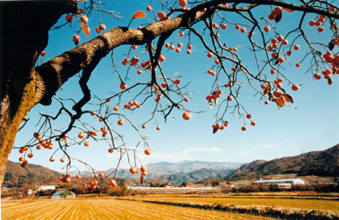Manzan benigaki
Ogawa Shinsuke, Peng Xiaolian
Japan 2001 |
| |
|
 |
|
|
Delphi
10.02., 14.00
CinemaxX 3
11.02., 12.45
Arsenal 1
11.02., 19.30
Babylon
12.02., 17.00
|
|
|
|
|
Produktion: The Kaminoyama Delicacy
Benigaki Documentary Film Production
Committee, Planet Bibliothèque de Cinéma
Weltvertrieb: Planet Bibliothèque de Cinéma
Yasui Yoshio, 203 Kansai-chuo Bldg. Bekkan,
15-2 Doyama-cho, Kita-ku, Osaka, Japan
Tel.: (81-6) 6364 2165, Fax: 6312 8232
e-mail: planet1@m11.alpha-net.ne.jp
Kamera: Tamura Masaki, Jong Lin
Ton: Kikuchi Nobuyuki, Kikuchi Shinpei
Schnitt: Peng Xiaolian
Musik: Jomon Daiko
Format: 16mm, Farbe
Länge: 90 Minuten, 24 Bilder/Sek.
Sprache: japanisch |
|
|
|
| Vor fast achtzehn Jahren begann Ogawa Shinsuke einen Film
über die rote Kakipflaume zu drehen, eine ungewöhnliche japanische
Frucht, die immer seltener angebaut wird. Er erlebte die Fertigstellung
seines Werkes nicht mehr. An seiner statt hat es nun die chinesische Regisseurin
Peng Xiaolian unternommen, die Arbeit Ogawas zu vollenden. Sie konnte sich
dabei auf die von ihm hinterlassenen Originalaufnahmen und Schnittanweisungen
stützen und filmte zusätzliches Material. So ist ein umfassender
Einblick in die Welt dieser kleinen, auf seltsame Weise charmanten Frucht
und der Menschen, die im Gebiet von Kaminoyama leben, gelungen. Peng Xiaolian:
„Es ist nicht nur Ogawas ausdrucksstarke Filmsprache, sondern auch
sein Respekt vor der japanischen Kultur, der uns inspirierte. Ihm ist es
zu verdanken, dass wir zusammengekommen sind, um seinen Film zu vollenden,
obwohl er bereits vor neun Jahren gestorben ist und der Kameraman Jong Lin
und ich Chinesen sind. Wir haben versucht, den Film in seinem Sinne zu beenden.
Ogawa setzte seine profunden Kenntnisse und seine tiefe persönliche
Beziehung zu diesem Land ein, um einem sehr speziellen Teil der japanischen
Kultur ein Denkmal zu setzen und dessen Schönheit mit uns und zukünftigen
Generationen zu teilen.“ |
| |
|
|
Using film footage and composition notes
left by Ogawa Shinsuke, Chinese director
Peng Xiaolian shot additional film and
completed the work, which colourfully yet
elegantly depicts the manufacturing process
of the Kaminoyama red persimmon. It
also features fascinating portraits of the
people who invent and make the tools and
implements for persimmon culture, and the
tales of the old women who run the persimmon
trade. By giving this comprehensive
view, it illustrates the world of this
small but strangely charming fruit and of
the people who continue to live in the area
of Kaminoyama.
Peng Xiaolian: “This film, a record of a disappearing
Japanese way of life, was started
by Ogawa over 16 years ago. This time,
we tried to understand and complete his
unfinished work... When I sat in front of
the Steenbeck to cut the film, when I forwarded
and rewound old film reels many,
many times, I saw the working print had
suffered many scratches, and I still could
not help but be moved by Ogawa speaking
to us. It’s not only his powerful film language,
it’s also Ogawa’s devotion to Japanese
culture that inspired us. Because of
him, we were drawn together again to finish
this film even though he had passed
away nine years earlier, even though both
the cameraman Jong Lin and I are Chinese.
We tried to honour his steps, and finished
the movie guided by his spirit. Ogawa had
captured fading Japanese traditions differently
from most Japanese. He used his penetrating
knowledge and deep personal connection
to memorialise a very special part
of Japanese culture and to share its beauty
with us and with future generations.“
|
| |
|
Biographien / Biographies
Ogawa Shinsuke, 1935-1992. Studium der Politologie und Wirtschaftswissenschaft.
1960 Beginn seiner wegweisenden Dokumentarfilmarbeit. Im Forum u.a. Das
Dörfchen Furuyashiki (1982) und Geschichten aus Magino – die tausenjährige
Son-nenuhr(1986).
Peng Xiaolian, Filmstudium in Beijing, Regiediplom von der NYU Film School.
Filme seit 1986, u.a. My Classmates (1986), A Woman’s Story (1988),
Once Upon a Time in Shanghai (1999). |
